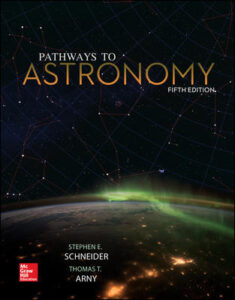Description
Test Bank For Pathways to Astronomy 5th Edition By Steven Schneider
Part 1 Test Bank – The Cosmic Landscape
The two nearest planets to the Earth are
1. The two nearest planets to the Earth are
A. Mercury and Venus
B. Mars and Jupiter
C. Venus and Mars
D. Pluto and Mars
Accessibility: Keyboard Navigation
Bloom’s Level: 1. Remember
Difficulty: Easy
Gradable: automatic
Part 1
Section: 01.03
Subtopic: Terrestrial Planets
Topic: Solar Systems
Unit: 01
The total number of planets orbiting the sun is __…
2. The total number of planets orbiting the sun is __.
A. 6
B. 7
C. 8
D. 10
Excluding Pluto there are 8 planets.
Accessibility: Keyboard Navigation
Bloom’s Level: 1. Remember
Difficulty: Easy
Gradable: automatic
Part 1
Section: 01.03
Subtopic: Jovian Planets
Subtopic: Terrestrial Planets
Topic: Solar Systems
Unit: 01
Venus’ radius as compared to the Earth’s radius i…
3. Venus’ radius as compared to the Earth’s radius is ___.
A. .53
B. .67
C. .10
D. .95
Venus is almost the same size as the Earth.
Accessibility: Keyboard Navigation
Bloom’s Level: 1. Remember
Difficulty: Easy
Gradable: automatic
Part 1
Section: 01.03
Subtopic: Differences Between Terrestrial Planets
Subtopic: Terrestrial Planets
Topic: Solar Systems
Topic: Terrestrial Planets
Unit: 01
The sun’s mass as compared to Earth is ___.
4. The sun’s mass as compared to Earth is ___.
A. 300,000 times smaller
B. 300,000 times larger
C. 100 times smaller
D. 100 times larger
The sun’s mass is 300,000 times that of Earth; its size is 100 times.
Accessibility: Keyboard Navigation
Bloom’s Level: 1. Remember
Difficulty: Easy
Gradable: automatic
Part 1
Section: 01.04
Subtopic: Solar Interior Structure
Topic: The Sun
Unit: 01
Earth is considered a planet.
5. Earth is considered a planet.
TRUE
Accessibility: Keyboard Navigation
Bloom’s Level: 1. Remember
Difficulty: Easy
Gradable: automatic
Part 1
Section: 01.01
Subtopic: Size, Shape and Composition of the Earth
Subtopic: The Pluto Decision
Topic: Asteroids, Meteors, and Comets
Topic: The Earth
Unit: 01
The Astronomical Unit is about 150 million km.
6. The Astronomical Unit is about 150 million km.
TRUE
Accessibility: Keyboard Navigation
Bloom’s Level: 1. Remember
Difficulty: Easy
Gradable: automatic
Part 1
Section: 01.06
Subtopic: Astronomical Unit (AU)
Topic: Language of Astronomy
Unit: 01
This is the system of several hundred billion star…
7. This is the system of several hundred billion stars in which our sun lives:
A. stellar populations
B. galactic cluster
C. Milky Way
D. solar system
Our sun lives in our Galaxy called the Milky Way.
Accessibility: Keyboard Navigation
Bloom’s Level: 1. Remember
Difficulty: Easy
Gradable: automatic
Part 1
Section: 02.02
Subtopic: Shape and Size of the Milky Way
Topic: The Milky Way Galaxy
Unit: 02
The Milky Way is moving toward this galaxy in our …
8. The Milky Way is moving toward this galaxy in our local cluster:
A. the magellanic clouds
B. M31
C. M101
D. edge of the universe
We will collide or nearly collide with M31 in about a billion years
Accessibility: Keyboard Navigation
Bloom’s Level: 1. Remember
Difficulty: Easy
Gradable: automatic
Part 1
Section: 02.04
Subtopic: Galaxy Interaction and Evolution
Topic: Galaxies
Unit: 02
Superclusters are ___________.
9. Superclusters are ___________.
A. collections of many clusters of galaxies
B. collections of many star clusters
C. our local group
D. the whole universe
Superclusters are clusters of galactic cluster.
Accessibility: Keyboard Navigation
Bloom’s Level: 1. Remember
Difficulty: Easy
Gradable: automatic
Part 1
Section: 02.04
Subtopic: Distribution of Galaxies
Subtopic: Galaxy Interaction and Evolution
Subtopic: Structure of the Universe
Topic: Cosmology
Topic: Galaxies
Unit: 02
The changes that a star goes through during its li…
10. The changes that a star goes through during its life are called
A. star clusters
B. stellar evolution
C. galaxies
D. stellar mass
Accessibility: Keyboard Navigation
Bloom’s Level: 1. Remember
Difficulty: Easy
Gradable: automatic
Part 1
Section: 02.01
Subtopic: High-mass Stellar Evolution
Subtopic: Low-mass Stellar Evolution
Topic: Stellar Evolution
Unit: 02
The local group are the closest galaxies to our Mi…
11. The local group are the closest galaxies to our Milky Way.
TRUE
Accessibility: Keyboard Navigation
Bloom’s Level: 1. Remember
Difficulty: Easy
Gradable: automatic
Part 1
Section: 02.04
Subtopic: Clusters and Superclusters
Subtopic: Local Group
Topic: Galaxies
Unit: 02
A light year is about 10 trillion km (6 trillion m…
12. A light year is about 10 trillion km (6 trillion miles).
TRUE
Accessibility: Keyboard Navigation
Bloom’s Level: 1. Remember
Difficulty: Easy
Gradable: automatic
Part 1
Section: 02.03
Subtopic: Light Year
Topic: Language of Astronomy
Unit: 02
If you express .0000003 in scientific notation, yo…
13. If you express .0000003 in scientific notation, you would show it as _____.
A. 3×10-6
B. 3×10-7
C. 3×10-8
D. 3×10-5
Moving the decimal to the left makes a bigger negative number.
Accessibility: Keyboard Navigation
Bloom’s Level: 3. Apply
Difficulty: Medium
Gradable: automatic
Part 1
Section: 03.02
Subtopic: Scientific Notation
Topic: Language of Astronomy
Unit: 03
Density is ______.
14. Density is ______.
A. mass per length
B. mass per volume
C. mass per area
D. mass per force
Mass per volume is used in MKS using kgs and meters.
Accessibility: Keyboard Navigation
Bloom’s Level: 1. Remember
Difficulty: Easy
Gradable: automatic
Part 1
Section: 03.01
Subtopic: Average Density
Subtopic: Size, Shape and Composition of the Earth
Topic: Solar Systems
Topic: The Earth
Unit: 03
The MKS system stands for
15. The MKS system stands for
A. many kilometers seconds.
B. meter kilometers seconds.
C. meter kilograms seconds.
D. centimeters grams seconds.
The MKS system is also called the SI units which is translated as the international system
Accessibility: Keyboard Navigation
Bloom’s Level: 1. Remember
Difficulty: Easy
Gradable: automatic
Part 1
Section: 03.01
Subtopic: Light Year
Topic: Language of Astronomy
Unit: 03
632,000 is the same as

Reviews
There are no reviews yet.